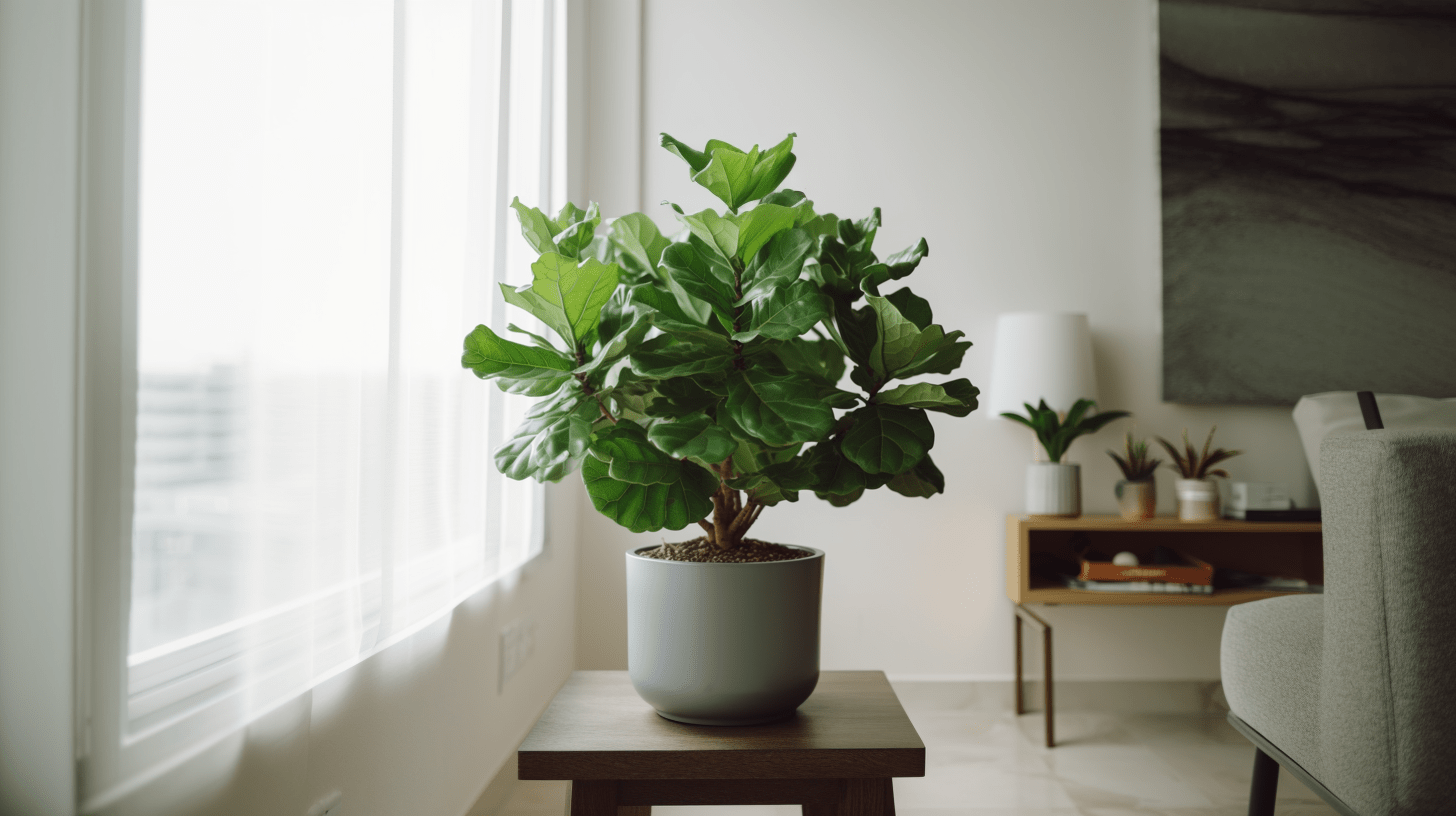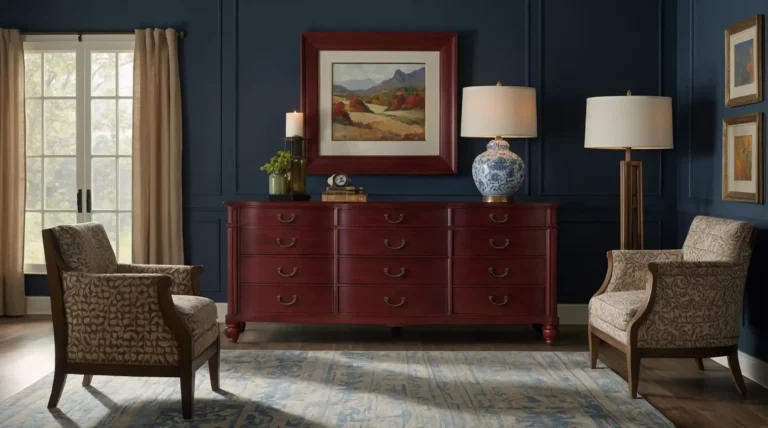7 Facts Nobody Tells You About Fiddle-Leaf Fig Trees
Fiddle-Leaf Fig Trees are popular indoor plants known for their large, glossy leaves. They require bright, indirect light and moderate watering.
Fiddle-leaf fig Trees (Ficus lyrata) have become a staple in modern home decor due to their striking appearance.
These tropical plants boast large, violin-shaped leaves that add a touch of elegance to any room. Originating from West Africa, they thrive in warm, humid environments but can adapt to indoor settings with proper care.

Place them near a window with filtered light, and ensure their soil remains slightly moist but not waterlogged.
Regular dusting of the leaves helps maintain their glossy look. With the right conditions, Fiddle-Leaf Fig Trees can grow impressively tall, making them a stunning focal point in any space.
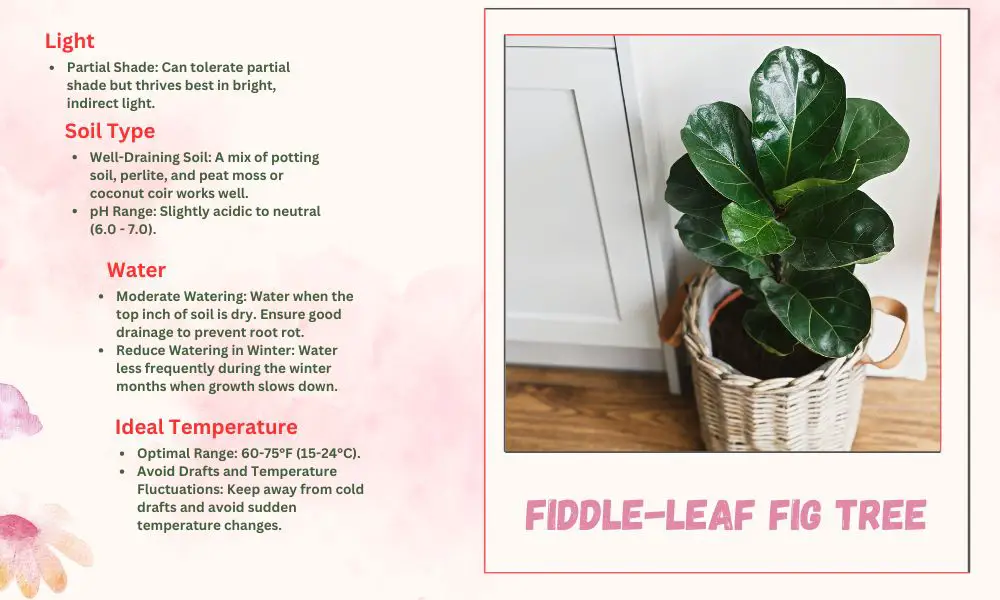
The Fiddle-leaf Fig Tree
Fiddle-Leaf Fig Trees are the stars of indoor plants. Their bold leaves and impressive size bring a touch of the tropical jungle into your home.
Known scientifically as Ficus lyrata, these trees have become a favorite among plant enthusiasts and interior designers.
Let’s dive deeper into the world of the Fiddle-Leaf Fig Tree.
Introduction
The Fiddle-Leaf Fig Tree is a popular houseplant known for its large, violin-shaped leaves. These leaves are visually striking and create a lush, green atmosphere.
This tree can grow up to 10 feet tall indoors, making it a dramatic addition to any room.
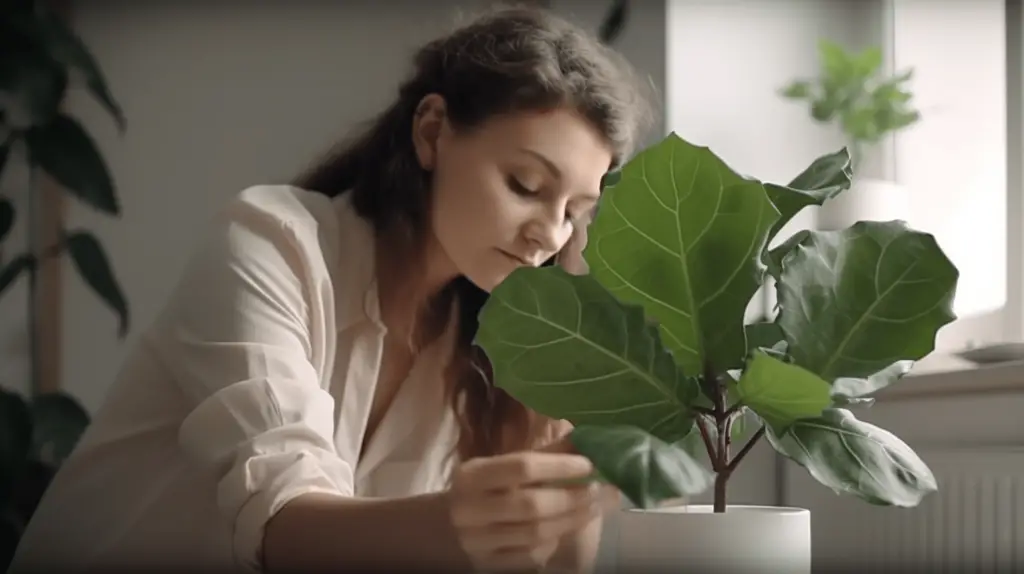
Here are some reasons why people love Fiddle-Leaf Fig Trees:
- Visual Appeal: Their large leaves and tall stature make them a statement piece.
- Air Purification: They help purify the air by removing toxins.
- Low Maintenance: With the right care, they are easy to maintain.
Fiddle-Leaf Fig Trees thrive in bright, indirect light. They prefer moderate watering, allowing the soil to dry out between waterings. Regularly cleaning their leaves helps them photosynthesize better.
These trees can be a bit finicky, but their beauty makes the effort worthwhile.

Origins And Characteristics
The Fiddle-Leaf Fig Tree originates from the tropical rainforests of West Africa. In the wild, they can grow up to 40 feet tall.
Their natural habitat provides them with ample sunlight and high humidity. Replicating these conditions indoors helps them thrive.
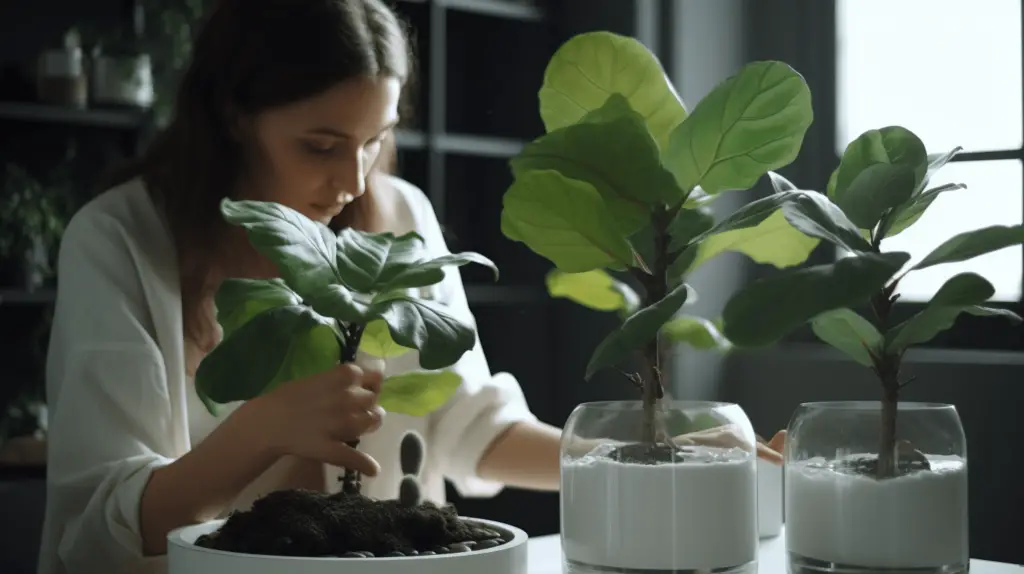
Key characteristics of Fiddle-Leaf Fig Trees include:
| Characteristic | Description |
|---|---|
| Leaves | Large, glossy, violin-shaped leaves with prominent veins. |
| Height | It can reach up to 10 feet indoors and 40 feet in the wild. |
| Light | Prefers bright, indirect light. |
| Watering | Moderate; allow soil to dry between waterings. |
Fiddle-leaf fig Trees have robust, woody trunks. This trunk supports their large leaves and adds to their majestic appearance. Proper pruning can help manage their height and shape. It’s important to note that they are sensitive to environmental changes.
Moving them too often can cause stress and leaf drop.
Overall, the Fiddle-Leaf Fig Tree is a stunning addition to any home. Understanding their origins and characteristics can help you provide the best care for these beautiful trees.
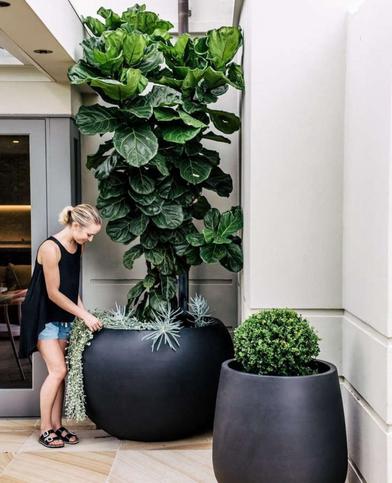
Caring For Your Fiddle-leaf Fig Tree
The Fiddle-Leaf Fig Tree is a popular indoor plant known for its large, glossy leaves. Caring for your Fiddle-Leaf Fig Tree can be rewarding but requires understanding its needs.
Let’s dive into the essentials of keeping your Fiddle-Leaf Fig Tree healthy and vibrant.
Light And Location
Fiddle-leaf fig Trees thrive in bright, indirect light. Place your plant near a window where it can get ample sunlight but avoid direct rays that can scorch the leaves.
An east-facing window is ideal. Rotate the plant every few weeks to ensure even growth and prevent it from leaning towards the light source.
Here are some tips for the best placement:
- Keep the plant away from drafts and air conditioning vents.
- Avoid placing it in low-light areas; this can hinder growth.
- During winter, move the plant closer to a window for more light.
Avoid sudden changes in light exposure. Gradually adjust the plant to new lighting conditions to prevent shock.
You can also read this post: 8 Plants and Herbs that Keep Bugs Away
Watering And Humidity
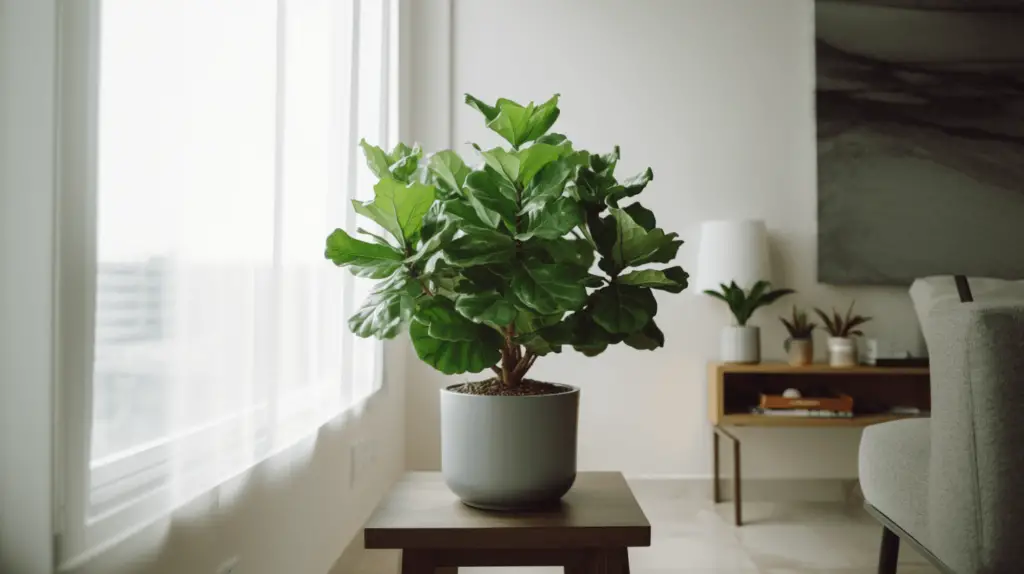
Proper watering is crucial for a Fiddle-Leaf Fig Tree. Overwatering can lead to root rot, while underwatering can cause the leaves to dry out.
Water the plant when the top inch of soil feels dry to the touch. Use a pot with drainage holes to prevent water from sitting at the bottom.
Here’s a simple watering guide:
- Check the soil moisture weekly.
- Water thoroughly until water drains out of the bottom.
- Reduce watering in the winter months.
Fiddle-Leaf Fig Trees also love humidity. Increase humidity by misting the leaves regularly or placing a humidifier nearby. You can also use a pebble tray filled with water under the pot.
Soil And Fertilization
Well-draining soil is essential for a Fiddle-Leaf Fig Tree. Use a high-quality potting mix that retains moisture and allows excess water to drain.
A mix designed for indoor plants or one with peat moss, perlite, and pine bark works well.
Fertilize your plant during the growing season (spring and summer). Use a balanced, water-soluble fertilizer every 4-6 weeks.
Here’s a simple fertilization schedule:
| Season | Frequency | Type |
|---|---|---|
| Spring | Every 4 weeks | Balanced, water-soluble |
| Summer | Every 6 weeks | Balanced, water-soluble |
| Fall | Once | Slow-release |
| Winter | None | N/A |
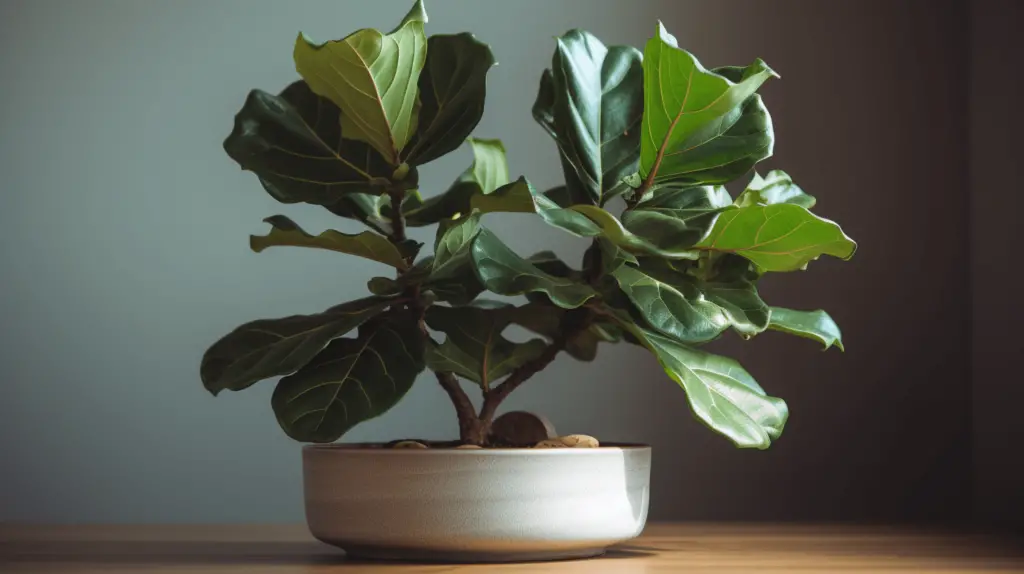
Pruning And Maintenance
Regular pruning helps maintain the shape and health of your Fiddle-Leaf Fig Tree. Remove dead or damaged leaves with clean, sharp scissors.
Pruning also encourages new growth and makes the plant bushier.
Here are some pruning tips:
- Identify the leaves that need to be removed.
- Cut close to the base of the leaf stem.
- Disinfect scissors between cuts to prevent disease.
Maintenance also includes cleaning the leaves. Dust can block sunlight and reduce the plant’s ability to photosynthesize. Use a damp cloth to wipe the leaves gently every few weeks.
By following these care tips, your Fiddle-Leaf Fig Tree will thrive and add a touch of nature to your home.
Common Issues And Troubleshooting
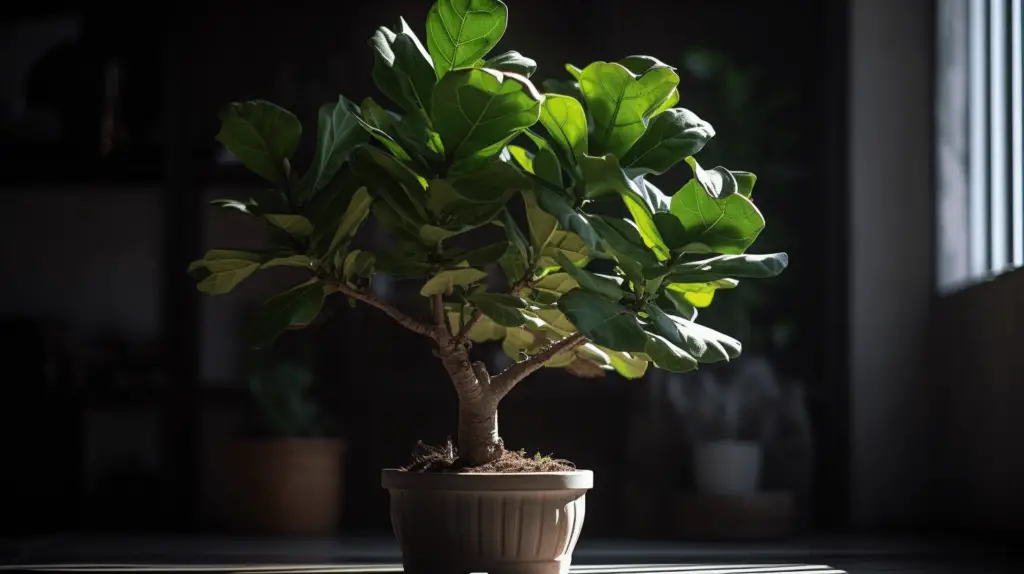
Fiddle-leaf fig Trees are popular indoor plants known for their large, glossy leaves. Despite their beauty, they can be tricky to care for.
Understanding common issues and troubleshooting can help keep your Fiddle-Leaf Fig thriving.
Yellowing Leaves
Yellowing leaves on a Fiddle-Leaf Fig can be alarming. This issue often stems from improper care. Here are some potential causes:
- Overwatering: Excessive water can lead to root rot, causing leaves to turn yellow.
- Underwatering: Lack of water can also make leaves yellow and dry.
- Improper Lighting: Fiddle-Leaf Figs need bright, indirect light. Too little light can cause yellowing.
- Nutrient Deficiency: Lack of essential nutrients can lead to yellow leaves.
To troubleshoot yellowing leaves:
- Check the soil moisture. Ensure it’s not too wet or too dry.
- Move the plant to a location with bright, indirect light.
- Fertilize with a balanced plant food every month.
Brown Spots And Leaf Drop
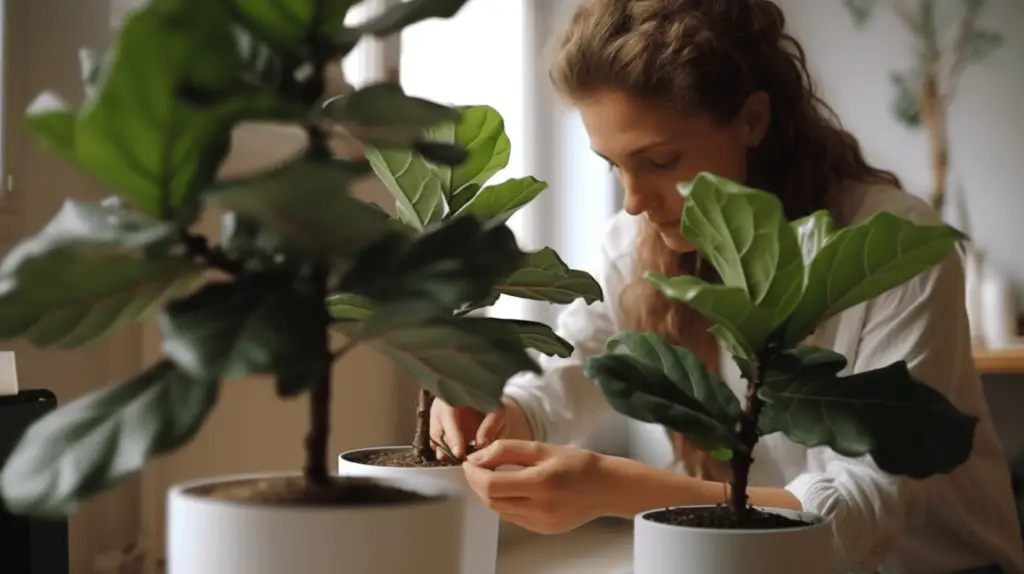
Brown spots and leaf drops are common issues with Fiddle-Leaf Fig Trees. They can occur due to various reasons:
- Inconsistent Watering: Irregular watering can cause stress, leading to brown spots and leaf drops.
- Low Humidity: These trees thrive in humid environments. Low humidity can cause brown edges and spots.
- Temperature Fluctuations: Sudden temperature changes can stress the plant, causing leaf drop.
- Fungal Infections: Overwatering can lead to fungal infections, resulting in brown spots.
To address brown spots and leaf drop:
- Maintain a consistent watering schedule.
- Increase humidity by misting the leaves or using a humidifier.
- Keep the plant away from drafts and direct heat sources.
- Use a fungicide if you suspect a fungal infection.
Pests And Diseases
Pests and diseases can damage Fiddle-Leaf Fig Trees. Some common pests include:
- Spider Mites: These tiny pests can cause yellowing and webbing on leaves.
- Mealybugs: They appear as white, cotton-like masses on leaves and stems.
- Scale Insects: These pests attach to the leaves and stems, sucking sap and causing yellow spots.
Common diseases include:
- Root Rot: Caused by overwatering, leading to mushy roots and yellow leaves.
- Leaf Spot: Fungal disease causing dark spots on leaves.
To combat pests and diseases:
- Inspect the plant regularly for signs of pests.
- Wipe leaves with a damp cloth to remove pests.
- Use insecticidal soap or neem oil to treat infestations.
- Ensure proper watering to prevent root rot.
- Remove affected leaves and use a fungicide for fungal infections.
Propagating Fiddle-leaf Fig Trees
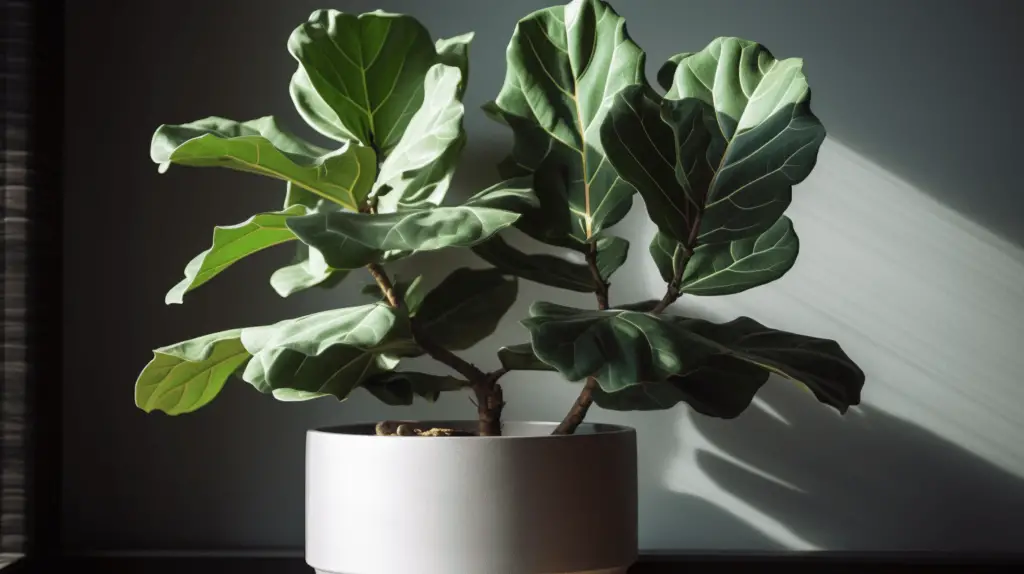
Fiddle-Leaf Fig Trees are popular indoor plants known for their large, lush leaves. Propagating Fiddle-Leaf Fig Trees can be a rewarding experience, allowing you to grow new plants from a single tree.
This process is fun and cost-effective, giving you more plants without buying new ones. Let’s explore the best methods and tips for successful propagation.
Methods Of Propagation
There are several methods to propagate Fiddle-Leaf Fig Trees. The most common techniques include stem cuttings, air layering, and leaf cuttings.
Each method has its own steps and requirements. Here’s a detailed look:
- Stem Cuttings: This is the easiest and most popular method. You will need a healthy branch with at least two leaves. Cut the stem below a node, place it in water or soil, and wait for roots to develop.
- Air Layering: This method is slightly more advanced. It involves making a small cut on a branch, wrapping it with moist sphagnum moss, and covering it with plastic wrap. Roots will form at the cut site, and you can then cut the branch and plant it.
- Leaf Cuttings: This method is less common but still effective. Take a healthy leaf with a small piece of the stem attached. Place it in water or soil, and the roots will eventually grow.
| Method | Difficulty | Time to Root |
|---|---|---|
| Stem Cuttings | Easy | 2-4 weeks |
| Air Layering | Moderate | 4-6 weeks |
| Leaf Cuttings | Challenging | 6-8 weeks |
Tips For Success
To ensure successful propagation, follow these essential tips:
- Choose a Healthy Plant: Start with a healthy, disease-free parent plant. This increases the chances of successful propagation.
- Use Clean Tools: Sterilize your cutting tools to prevent infections. This keeps your new plants healthy.
- Provide Adequate Light: Place the cuttings in a bright, indirect light. Direct sunlight can harm young plants.
- Maintain Humidity: Keep the humidity high around the cuttings. You can use a plastic bag or a humidity dome.
- Be Patient: Propagation takes time. Be patient and avoid disturbing the cuttings too much.
- Check for Roots: Regularly check for root development. Once roots are visible, you can transplant the cuttings to a larger pot.
Following these tips will help you successfully propagate Fiddle-Leaf Fig Trees. Enjoy watching your new plants grow and thrive!
Decorating With Fiddle-leaf Fig Trees
The Fiddle-Leaf Fig Tree is popular for indoor and outdoor decor. Its large, glossy leaves and striking appearance can transform any space.
Whether you’re decorating your living room or enhancing your garden, this plant offers endless possibilities.
Below, we explore how to incorporate Fiddle-Leaf Fig Trees into your home and garden.
Indoor Decor
Fiddle-Leaf Fig Trees are perfect for indoor decor. Their large leaves and bold presence make them a focal point in any room.
Here are some ways to use them indoors:
- Living Room: Place the tree near a window to ensure it gets plenty of light. The large leaves will create a lush, tropical feel.
- Bedroom: A Fiddle-Leaf Fig Tree can add a touch of nature to your sleeping space. Place it in a corner for a calming effect.
- Office: Brighten up your workspace by placing a small Fiddle-Leaf Fig on your desk or in a corner.
Here is a quick guide to help you place your Fiddle-Leaf Fig indoors:
| Room | Placement | Benefits |
|---|---|---|
| Living Room | Near a window | Enhances natural light |
| Bedroom | Corner | Creates a calming atmosphere |
| Office | Desk or corner | Boosts productivity |
Always remember to water your Fiddle-Leaf Fig Tree moderately. Overwatering can lead to root rot, while underwatering can cause the leaves to droop.
Outdoor Landscaping

Fiddle-leaf fig Trees can also be a stunning addition to your outdoor landscaping. Their unique shape and size make them ideal for various outdoor settings. Here are some ideas:
- Patio: Place the tree in a large pot on your patio. It will create a cozy and inviting space.
- Garden: Plant the tree in a sunny spot in your garden. It will become a striking centerpiece.
- Entrance: Position a pair of Fiddle-Leaf Fig Trees on either side of your front door for a grand entrance.
Consider these tips for outdoor Fiddle-Leaf Fig Tree care:
- Sunlight: Ensure the tree gets at least 6 hours of sunlight daily.
- Watering: Water the tree deeply once a week.
- Soil: Use well-draining soil to prevent root rot.
Here is a quick reference table for outdoor placement:
| Location | Placement | Benefits |
|---|---|---|
| Patio | Large pot | Creates a cozy space |
| Garden | Sunny spot | Striking centerpiece |
| Entrance | Either side of the door | Grand entrance |
By following these tips, you can enjoy the beauty of Fiddle-Leaf Fig Trees both indoors and outdoors.
Fiddle-leaf Fig Tree Varieties
The fiddle-leaf fig tree is a favorite among indoor plant enthusiasts. Its large, glossy leaves and elegant stature make it a stunning addition to any home.
There are various varieties of fiddle-leaf fig trees, each with unique characteristics.
Understanding these differences can help you choose the best one for your space and needs.
Popular Cultivars
There are several popular cultivars of the fiddle-leaf fig tree. Each has its own charm and appeal. Here are a few well-loved varieties:
- Ficus lyrata: The most common variety, known for its large, violin-shaped leaves.
- Ficus lyrata ‘Bambino’: A dwarf version, perfect for smaller spaces.
- Ficus lyrata ‘Compacta’: Features smaller, more compact leaves, making it easier to manage.
Let’s look at these popular cultivars in more detail:
| Variety | Description |
|---|---|
| Ficus lyrata | It is a smaller, more compact version. The leaves are still large, but the plant is still stremainsetite. |
| Ficus lyrata ‘Bambino’ | It is a smaller, more compact version. The leaves are still large, but the plant is still stremainsetite. |
| Ficus lyrata ‘Compacta’ | This cultivar has smaller, denser leaves, making it easier to maintain indoors. |
Differences And Features
Each fiddle-leaf fig variety has unique features. Understanding these can help you select the perfect plant for your needs:
- Leaf Size: The standard Ficus lyrata has the largest leaves. ‘Bambino’ and ‘Compacta’ have smaller leaves.
- Growth Habit: The standard Ficus lyrata grows tall, making it great for large spaces. ‘Bambino’ and ‘Compacta’ are more compact and suitable for smaller areas.
- Maintenance: Smaller varieties like ‘Bambino’ and ‘Compacta’ require less pruning.
Let’s compare these differences in a clear table:
| Feature | Ficus lyrata | Ficus lyrata ‘Bambino’ | Ficus lyrata ‘Compacta’ |
|---|---|---|---|
| Leaf Size | Large | Medium | Small |
| Growth Habit | Tall | Compact | Compact |
| Maintenance | High | Medium | Low |
Choosing the right fiddle-leaf fig depends on your space, maintenance preferences, and aesthetic goals.
Each variety brings its own unique charm to your home.
Fiddle-leaf Fig Tree And Your Health
Fiddle-leaf fig Trees are not just stunning decor pieces. They offer numerous health benefits that can enhance your daily life.
This post explores how Fiddle-Leaf Fig Trees can positively impact your health, focusing on air purification and emotional well-being.
Air Purification
Fiddle-leaf fig Trees are natural air purifiers.
They help improve indoor air quality by removing toxins and releasing fresh oxygen. Here are some key benefits:
- Removes Toxins: The leaves absorb harmful chemicals like formaldehyde and benzene.
- Increases Humidity: They add moisture to the air, reducing the risk of dry skin and respiratory issues.
- Reduces Dust: Fiddle-leaf fig Trees trap dust particles, making your home cleaner.
According to NASA’s Clean Air Study, indoor plants can remove up to 87% of toxins in the air within 24 hours.
This makes Fiddle-Leaf Fig Trees an excellent choice for your home or office.
| Benefit | Details |
|---|---|
| Removes Toxins | Absorbs harmful chemicals from the air |
| Increases Humidity | Adds moisture to reduce dry skin and respiratory issues |
| Reduces Dust | Traps dust particles, keeping your space clean |
Emotional Well-being
Fiddle-leaf fig Trees can boost your emotional well-being. Their lush, green leaves create a calming environment.
Here are some emotional benefits:
- Reduces Stress: Studies show that being around plants lowers stress levels.
- Enhances Mood: Greenery promotes feelings of happiness and tranquility.
- Boosts Productivity: Plants improve focus and concentration, making you more productive.
Imagine having a Fiddle-Leaf Fig Tree in your living room. Its vibrant leaves can make you feel more relaxed and at peace.
This positive impact on your mood can lead to a healthier, happier life.
Research from the Journal of Environmental Psychology found that indoor plants can reduce stress and improve overall well-being.
This makes Fiddle-Leaf Fig Trees a valuable addition to any home.
:max_bytes(150000):strip_icc()/grow-fiddle-leaf-fig-indoors-1902756-hero-feca31e64e91430794e2bdcc9fa1e901.jpg)
The Fiddle-leaf Fig Tree In Pop Culture
The Fiddle-Leaf Fig Tree has become a beloved houseplant in recent years. Known for its large, vibrant leaves, it adds a touch of nature to any space.
Beyond its aesthetic appeal, the Fiddle-Leaf Fig Tree has also significantly impacted pop culture.
From appearing in celebrity homes to dominating social media feeds, this plant is more than just a leafy friend; it’s a cultural icon.
Celebrity Homes
Many celebrities have embraced the Fiddle-Leaf Fig Tree in their homes. These trees are often showcased in interior design magazines and celebrity home tours.
Here are a few famous figures who adore this plant:
- Oprah Winfrey: Oprah’s love for Fiddle-Leaf Figs is well-documented. She has several of these plants in her home, adding a touch of greenery to her luxurious spaces.
- Michelle Obama: The former First Lady has been spotted with a Fiddle-Leaf Fig in her home office. It adds a calming presence to her busy workspace.
- Chrissy Teigen: Chrissy often shares glimpses of her home on social media, and her Fiddle-Leaf Fig is a recurring star. The plant fits perfectly with her chic décor.
These celebrity endorsements have boosted the plant’s popularity. People want to emulate the stylish homes of their favorite stars.
Below is a table summarizing some of the celebrities and their Fiddle-Leaf Fig Trees:
| Celebrity | Location | Notable Features |
|---|---|---|
| Oprah Winfrey | Living Room | Multiple Large Plants |
| Michelle Obama | Home Office | Single, Tall Plant |
| Chrissy Teigen | Living Room | Medium-Sized Plant |
Social Media Presence
The Fiddle-Leaf Fig Tree has a massive presence on social media platforms. Instagram is filled with posts showcasing this trendy plant. Influencers and plant enthusiasts share tips and tricks for caring for their Fiddle-Leaf Figs.
Here are some popular hashtags associated with the plant:
- #FiddleLeafFig: This hashtag has thousands of posts featuring beautiful Fiddle-Leaf Fig Trees in various settings.
- #PlantMom: This hashtag often includes Fiddle-Leaf Figs as part of the plant care community.
- #UrbanJungle: People use this tag to show off their indoor gardens, with Fiddle-Leaf Figs being a common feature.
Social media influencers have played a significant role in popularizing the Fiddle-Leaf Fig. They post tutorials on how to care for the plant, making it accessible to everyone.
Below is a list of popular Instagram accounts that frequently feature Fiddle-Leaf Figs:
- @urbanjungleblog: This account showcases beautiful indoor plants, including Fiddle-Leaf Figs.
- @thepottedjungle: A plant lover who shares tips and beautiful photos of her indoor garden.
- @houseplantclub: A community of plant enthusiasts who share their favorite houseplants, including Fiddle-Leaf Figs.
Fiddle-leaf fig Trees are a social media sensation with their lush leaves and dramatic appearance. They inspire plant lovers everywhere to bring a bit of nature indoors.
Frequently Asked Questions
Why Are Fiddle Leaf Figs So Hard To Care For?
Fiddle leaf figs are hard to care for due to their sensitivity to light, water, and humidity. They need consistent conditions and can be prone to pests and diseases.
Proper care requires vigilance and attention.
Do Fiddle Leaf Figs Need Direct Sunlight?
Fiddle leaf figs thrive in bright, indirect sunlight. Direct sunlight can scorch their leaves. Place them near a window with filtered light.
How To Care For A Fiddle Leaf Fig Tree?
Water it when the top inch of soil is dry. Provide bright, indirect light. Ensure proper drainage to avoid root rot. Wipe leaves to remove dust. Fertilize monthly during the growing season.
Is Fiddle Leaf Fig Indoor Or Outdoor?
Fiddle leaf figs are primarily indoor plants. They thrive in bright, indirect light and need stable indoor conditions.
Conclusion
Caring for Fiddle-Leaf Fig Trees brings both beauty and tranquility to your space. These stunning plants thrive with proper care.
Remember to provide adequate light, water, and humidity. Regular maintenance ensures a healthy, vibrant tree.
Enjoy the rewarding experience of nurturing your Fiddle-Leaf Fig, enhancing your home’s natural charm.

